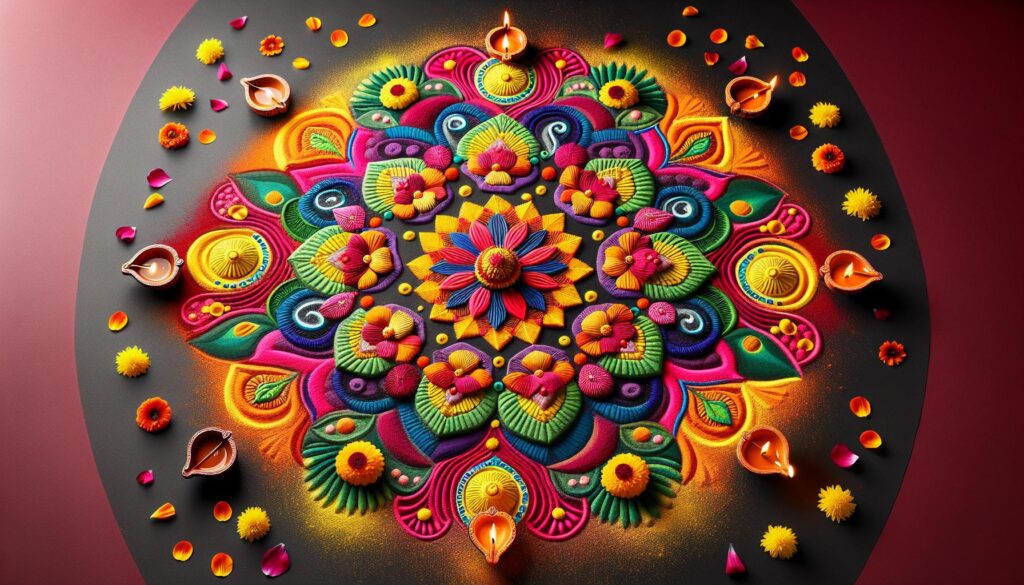
As Diwali approaches, I’m excited to share some stunning yet easy rangoli designs that’ll light up your home. Rangoli, the colorful art form that adorns doorways and floors during festivals, isn’t just beautiful—it’s a cherished tradition that brings luck and prosperity.
Key Takeaways
- Rangoli is a traditional Indian art form that symbolizes prosperity and good fortune during Diwali celebrations
- Easy rangoli designs focus on simple geometric patterns, limited colors, and larger elements, making them accessible for beginners and time-constrained individuals
- Essential materials for creating simple rangoli patterns include colored powders, rice flour, stencils, and decorative elements like flower petals and diyas
- Five easy rangoli designs for Diwali include floral, geometric, dot grid, diya-inspired, and freehand patterns
- Preserving rangoli designs can be achieved through fixatives, protective barriers, weather-resistant materials, and regular maintenance
Easy:5cqheyicgzo= Rangoli Designs For Diwali
Rangoli is an ancient Indian art form that involves creating intricate patterns on floors using colored powders, rice, flowers, or sand. It’s a vibrant and symbolic decoration that holds deep cultural significance, especially during Diwali.
During Diwali, rangoli serves multiple purposes:
- Welcoming deities: Hindus believe rangoli designs attract Goddess Lakshmi, bringing prosperity and good fortune.
- Spiritual symbolism: The patterns represent the cosmic wheel of life and the cyclical nature of existence.
- Aesthetic appeal: Colorful rangoli designs enhance the festive atmosphere and beautify homes.
- Community bonding: Creating rangoli often becomes a group activity, strengthening social ties.
Rangoli designs vary in complexity, from simple geometric shapes to elaborate pictorial representations. Traditional materials include:
- Colored powders (gulal)
- Rice flour
- Flower petals
- Sand
- Beads or sequins
The art of rangoli dates back thousands of years, with mentions in ancient Indian texts. It’s not just limited to Diwali; rangoli is created for various auspicious occasions throughout the year.
Creating rangoli is believed to bring:
- Positive energy
- Good luck
- Protection from evil forces
In modern times, rangoli has evolved beyond its traditional roots. Contemporary artists experiment with new materials and techniques, creating innovative designs while preserving the essence of this ancient art form.
Traditional vs. Easy Rangoli Designs
Traditional rangoli designs often feature intricate patterns and complex symmetry, requiring significant time and skill to create. These designs typically incorporate elaborate floral motifs, religious symbols, and geometric shapes that demand precision and patience. I’ve observed that traditional rangolis can take hours to complete, using fine powders and multiple colors to achieve stunning results.
Easy rangoli designs, on the other hand, simplify the process while maintaining the essence of this beautiful art form. These designs focus on:
- Geometric patterns: Simple shapes like circles, squares, and triangles
- Limited color palette: Using 2-3 colors instead of a wide range
- Larger elements: Bigger patterns that are quicker to fill
- Freehand drawing: Less emphasis on perfect symmetry
- Pre-made stencils: Templates to guide the design process
Easy rangoli designs are ideal for:
- Beginners learning the art
- Time-constrained individuals
- Children participating in festivities
- Daily rangoli practices
While traditional designs hold deep cultural significance, easy rangolis offer accessibility and inclusivity, allowing more people to participate in this cherished Diwali tradition. I’ve found that both styles serve important purposes in celebrating the festival of lights.
| Aspect | Traditional Rangoli | Easy Rangoli |
|---|---|---|
| Time required | 2-4 hours | 15-30 minutes |
| Skill level | Advanced | Beginner to Intermediate |
| Color usage | 5+ colors | 2-3 colors |
| Pattern complexity | High | Low to Medium |
| Materials | Fine powders, natural dyes | Ready-made colors, stencils |
Easy rangoli designs have gained popularity in recent years due to their practicality and adaptability. They allow for creative expression while accommodating modern time constraints and varying skill levels. I’ve noticed that many households now opt for a mix of traditional and easy designs throughout the Diwali celebration, creating a balance between preserving tradition and embracing contemporary lifestyles.
Materials Needed for Simple Rangoli Patterns
To create easy rangoli designs for Diwali, I’ll need:
- Colored powders: Vibrant hues like red, yellow, green, blue, and white
- Rice flour: White base for outlining patterns
- Stencils: Pre-made shapes for consistent designs
- Ruler: Straight lines and symmetrical patterns
- Sieve: Even distribution of fine powders
- Brushes: Small, medium for precise application
- Flower petals: Natural, colorful accents
- Diyas: Small oil lamps for illumination
- Glitter: Sparkle and shine to patterns
- Adhesive: Secure loose elements in windy conditions
These materials enable me to craft beautiful, simple rangoli designs efficiently. Colored powders and rice flour form the foundation, while stencils and rulers ensure precision. Flower petals and diyas add traditional touches, and glitter provides a festive sparkle. With these supplies, I’m ready to create stunning Diwali decorations that capture the spirit of the festival without requiring extensive artistic skills.
5 Easy Rangoli Designs for Diwali
I’ve selected five simple yet stunning rangoli designs perfect for Diwali celebrations. These patterns are easy to create, requiring minimal time and artistic skill while still capturing the festive spirit.
Floral Rangoli
Floral rangoli designs incorporate flower-inspired patterns, creating a vibrant and natural look. I use large, symmetrical flower shapes with bold petals and a central focal point. This design typically includes 3-5 colors, with contrasting hues for the petals and center. For added dimension, I sometimes incorporate real flower petals or leaves around the edges.
Geometric Rangoli
Geometric rangoli patterns feature clean lines and simple shapes, making them ideal for beginners. I start with a basic shape like a square or triangle, then build outward using concentric patterns. This design often uses 2-3 colors, with white or light colors as outlines and bolder hues for filling. Symmetry is key, so I use a ruler to ensure precise measurements.
Dot Grid Rangoli
Dot grid rangoli designs begin with a simple grid of evenly spaced dots. I connect these dots to create various patterns, from basic lines to more complex shapes. This method is highly customizable, allowing for creativity within a structured framework. I typically use 4-6 colors, alternating them to create a balanced look. The final design often resembles intricate lacework.
Diya-Inspired Rangoli
Diya-inspired rangoli designs center around the traditional oil lamp motif. I create a large central diya shape, surrounded by smaller flame patterns or concentric circles. This design usually incorporates warm colors like yellow, orange, and red to mimic the glow of actual diyas. For added effect, I place real lit diyas at key points within the rangoli.
Freehand Rangoli
Freehand rangoli offers the most creative freedom among these designs. I start with a central point and build outward organically, creating swirls, curves, and abstract shapes. This style works well with 3-4 complementary colors. While it may look complex, the beauty of freehand rangoli lies in its imperfections and unique character. It’s an excellent option for those who prefer a more relaxed, artistic approach to rangoli creation.
Tips for Creating Beautiful Yet Simple Rangoli
Choose the Right Location
I recommend selecting a clean, flat surface for your rangoli. Entryways, living room floors, or outdoor patios work well. Ensure the area is free from dust and moisture for better powder adhesion.
Start with a Basic Outline
Begin by drawing a simple outline using chalk or a light-colored powder. This serves as a guide for your design, making it easier to fill in details later.
Use Stencils for Precision
Stencils are invaluable for creating symmetrical patterns. I suggest using plastic or cardboard stencils for crisp lines and consistent shapes, especially for geometric designs.
Experiment with Color Combinations
Limit your color palette to 3-5 colors for a cohesive look. Traditional combinations include red and yellow, or green and orange. For a modern twist, try pastels or monochromatic schemes.
Incorporate Natural Elements
Enhance your rangoli with natural materials. Flower petals, leaves, or seeds add texture and a fresh, organic touch to your design.
Layer Your Design
Build depth by layering colors. Start with lighter shades as a base, then add darker hues on top. This technique creates a more dynamic and visually interesting rangoli.
Practice Proper Powder Application
For even distribution, use a sieve to sprinkle fine powders. For larger areas, pour powder directly from the container and spread it gently with your fingers or a brush.
Add Sparkle and Shine
Incorporate glitter or sequins strategically to make your rangoli pop. A little sparkle goes a long way in catching light and adding a festive touch.
Protect Your Design
If creating an outdoor rangoli, consider using a fixative spray to protect it from wind or light rain. For indoor designs, avoid high-traffic areas to maintain the pattern’s integrity.
Clean Up with Ease
Place a large sheet or newspaper around your work area to catch stray powder. This makes cleanup quick and easy, allowing you to enjoy your creation without worry.
How to Preserve Your Rangoli Design
Creating a beautiful rangoli is only half the battle – preserving it is equally important. Here are some effective methods to keep your rangoli design intact throughout the Diwali festivities:
Use Fixatives
Applying a fixative spray over your completed rangoli helps seal the design. I recommend using a clear, non-toxic fixative specifically designed for art projects. Spray it evenly from about 12 inches away, ensuring complete coverage without disturbing the pattern.
Create a Protective Barrier
For outdoor rangolis, consider creating a temporary barrier around the design. Use thin wooden strips or plastic sheets to form a low wall, protecting the rangoli from wind and accidental disturbances. This barrier also helps contain any loose powder.
Opt for Weather-Resistant Materials
When creating outdoor rangolis, choose materials that can withstand the elements. Acrylic paints, chalk markers, or even colored sand are more durable options compared to traditional powders. These materials adhere better to surfaces and resist fading or washing away.
Apply a Clear Sealant
For rangolis on concrete or stone surfaces, applying a clear, water-based sealant can significantly extend its lifespan. This method works best for designs created with paints or chalk. Apply the sealant carefully with a soft brush, avoiding disturbing the design.
Use Adhesive for Delicate Elements
When incorporating delicate elements like flower petals or glitter, use a light adhesive to secure them in place. A diluted white glue solution works well for this purpose. Apply it sparingly with a small brush to avoid altering the appearance of these elements.
Cover During Adverse Weather
If rain or strong winds are expected, cover your outdoor rangoli with a clear plastic sheet. Secure the edges of the sheet to prevent it from blowing away. Remove the cover once the weather improves to allow the rangoli to be visible again.
Regular Maintenance
Perform daily touch-ups to maintain the vibrancy of your rangoli. Gently brush away any debris and reapply colors where needed. This routine helps keep the design fresh throughout the Diwali celebration period.
By implementing these preservation techniques, your rangoli will remain a stunning centerpiece throughout the Diwali festivities, allowing you to fully enjoy the fruits of your creative efforts.
Easy Designs
Creating easy rangoli designs for Diwali is a fantastic way to embrace tradition while adapting to modern lifestyles. With simple techniques and readily available materials, anyone can create stunning designs that capture the festival’s spirit. I hope these ideas and tips inspire you to explore your creativity this Diwali. Remember, the beauty of rangoli lies not just in its appearance but in the joy and togetherness it brings. So gather your loved ones, pick up some colorful powders, and let your imagination shine through your rangoli creations. Happy Diwali!












